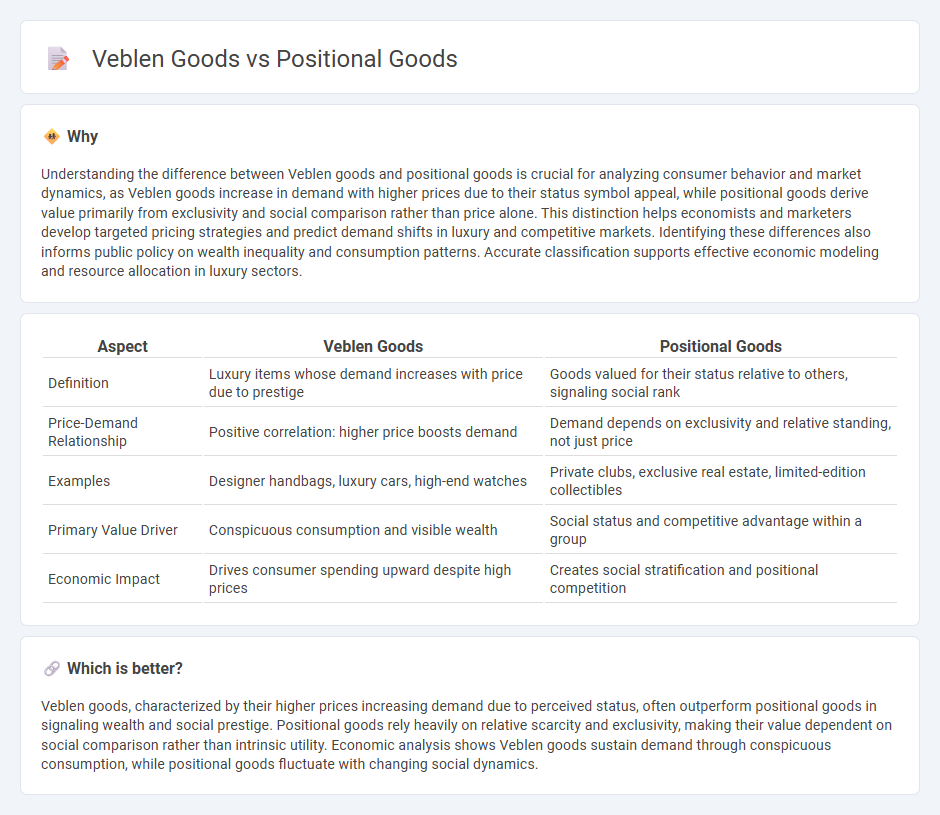
Veblen goods are luxury items whose demand increases as their price rises, driven by their status-symbol appeal, such as designer handbags or high-end watches. Positional goods derive value primarily from their exclusivity and social standing, meaning their worth depends on how they compare to others' possessions, like limited-edition collectibles or premium real estate in prestigious locations. Explore further to understand how these unique economic concepts influence consumer behavior and market dynamics.
Why it is important
Understanding the difference between Veblen goods and positional goods is crucial for analyzing consumer behavior and market dynamics, as Veblen goods increase in demand with higher prices due to their status symbol appeal, while positional goods derive value primarily from exclusivity and social comparison rather than price alone. This distinction helps economists and marketers develop targeted pricing strategies and predict demand shifts in luxury and competitive markets. Identifying these differences also informs public policy on wealth inequality and consumption patterns. Accurate classification supports effective economic modeling and resource allocation in luxury sectors.
Comparison Table
| Aspect | Veblen Goods | Positional Goods |
|---|---|---|
| Definition | Luxury items whose demand increases with price due to prestige | Goods valued for their status relative to others, signaling social rank |
| Price-Demand Relationship | Positive correlation: higher price boosts demand | Demand depends on exclusivity and relative standing, not just price |
| Examples | Designer handbags, luxury cars, high-end watches | Private clubs, exclusive real estate, limited-edition collectibles |
| Primary Value Driver | Conspicuous consumption and visible wealth | Social status and competitive advantage within a group |
| Economic Impact | Drives consumer spending upward despite high prices | Creates social stratification and positional competition |
Which is better?
Veblen goods, characterized by their higher prices increasing demand due to perceived status, often outperform positional goods in signaling wealth and social prestige. Positional goods rely heavily on relative scarcity and exclusivity, making their value dependent on social comparison rather than intrinsic utility. Economic analysis shows Veblen goods sustain demand through conspicuous consumption, while positional goods fluctuate with changing social dynamics.
Connection
Veblen goods and positional goods are linked through their value driven by social status rather than intrinsic utility, with demand increasing as prices rise due to their exclusivity and prestige. Both types of goods serve as status symbols, where consumption signals wealth and rank within a social hierarchy. This dynamic influences consumer behavior and market patterns, impacting economic theories on demand and luxury branding strategies.
Key Terms
Status
Positional goods derive value from their scarcity and the exclusivity they confer, appealing primarily to social status and competitive consumption. Veblen goods, a subset of positional goods, see demand increase as their price rises, often because higher prices enhance their status symbol appeal. Explore the distinctions between these economic concepts to better understand consumer behavior and market dynamics.
Conspicuous consumption
Positional goods derive value from their exclusivity and social rank, often sought to signal status within a competitive social hierarchy. Veblen goods exhibit increased demand as prices rise, driven by conspicuous consumption where higher prices enhance desirability and social prestige. Explore the distinctions and implications of these goods to better understand consumer behavior and market dynamics.
Relative scarcity
Positional goods derive value primarily from their relative scarcity and exclusivity, making them sought-after due to limited availability compared to others. Veblen goods, a subset of positional goods, gain demand as their prices increase, symbolizing status and wealth through conspicuous consumption. Explore more to understand how relative scarcity drives consumer behavior in luxury markets.
Source and External Links
Positional good - Wikipedia - Positional goods are items valued primarily for their scarcity and distribution relative to others, often serving as status symbols whose worth depends on their exclusivity rather than abundance.
6 Types of Positional Good - Simplicable - Positional goods include luxury products, scarce resources, education, memberships, and events that consumers desire more as their income rises due to their limited supply and status value.
Positional Goods, AI Pushback, And More - Sahil Vaidya - Positional goods are acquired for the exclusive status and differentiation they provide, with people often prioritizing relative advantage over absolute gains in such goods.
 dowidth.com
dowidth.com